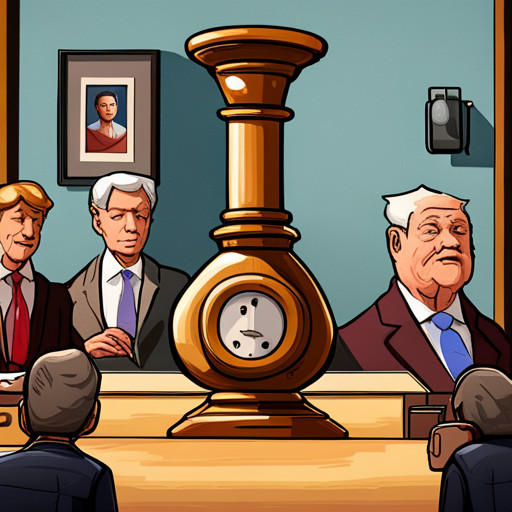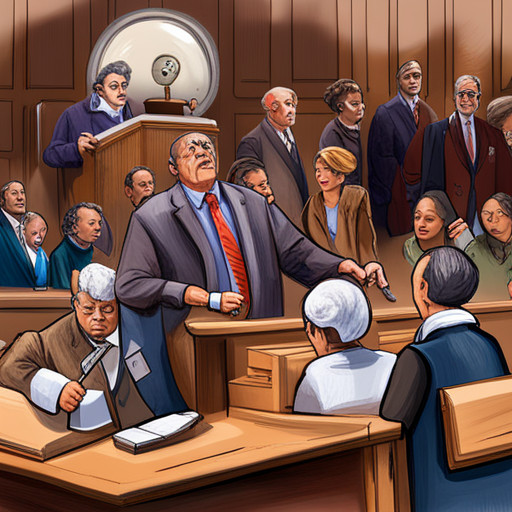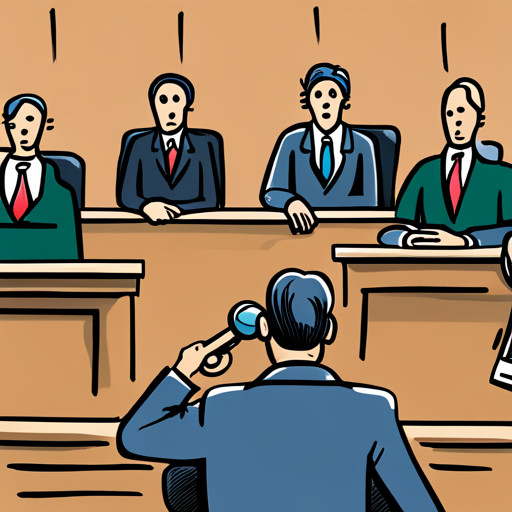Tepezza Lawsuits Hearing Loss From Thyroid Eye Drug
This article investigates the unfolding legal controversy surrounding Tepezza, a drug used for treating thyroid eye disease (TED).

It explores the connection between Tepezza and reported hearing loss incidents, scrutinizes the allegations made in pending lawsuits, and evaluates the updated FDA warning.
The potential impact on affected patients and the likelihood of a new class-action MDL are also examined, providing comprehensive insight into this significant healthcare and legal issue.
Key Takeaways
- Tepezza, an injectable prescription drug used for the treatment of thyroid eye disease (TED), has been linked to permanent hearing damage and/or tinnitus.
- Patients who have experienced hearing loss or tinnitus after receiving Tepezza injections may be eligible for a product liability lawsuit.
- Tepezza lawsuits allege that patients and their physicians were not adequately warned about the risk of hearing loss or tinnitus.
- The FDA has updated Tepezza's warning to include the risk of severe and irreversible auditory damage.
Understanding Thyroid Eye Disease and Tepezza

Tepezza, the first and only FDA-approved medication for treating Thyroid Eye Disease (TED), works by blocking the activity of the insulin-like growth factor 1 receptor (IGF-1R), making it a unique treatment for this rare autoimmune disorder characterized by inflammation and swelling of the tissues around the eyes. This can result in symptoms such as eye-bulging, double vision, and eye pain.
This illustrates Tepezza's mechanism of action, which is specifically designed to target and reduce the overactivity of IGF-1R, a significant causal contributor to the symptoms of thyroid eye disease. By blocking IGF-1R, Tepezza minimizes the inflammation and swelling of ocular tissues, thus alleviating the distressing symptoms associated with this condition.
The Link Between Tepezza and Hearing Loss

Newly published scientific research indicates a potential correlation between the administration of certain injectable prescription medications used for the treatment of autoimmune disorders and the onset of irreversible auditory damage. One such medication, Tepezza, used in the treatment of Thyroid Eye Disease (TED), has been linked to cases of permanent hearing loss.
- Tepezza, an FDA-approved medication, exhibits side effects that include irreversible hearing loss.
- Scientific research highlights a correlation between Tepezza administration and auditory damage.
- Legal remedies for Tepezza hearing loss include product liability lawsuits.
- Lawsuits allege lack of adequate warning about potential hearing loss.
- The FDA has since updated Tepezza's warning to include the risk of severe auditory damage.
This emphasizes the importance of understanding potential side effects and seeking legal aid in cases of unexpected adverse reactions.
Details of Tepezza’s FDA Warning Update

Following reported cases of irreversible auditory damage, the U.S. Food and Drug Administration (FDA) has revised the warning label for the injectable prescription medication to include the risk of severe hearing impairment.
This revised label is a part of Tepezza's FDA warning update, aimed at alerting physicians and patients about the potential auditory risks associated with the medication.
The update emphasizes the long term effects of Tepezza on hearing loss, which can be permanent or severe.
Research has shown a correlation between the use of Tepezza and increased instances of auditory damage.
The warning update is a critical step towards ensuring patient safety and informed consent in the administration of Tepezza for treating thyroid eye disease.
Examination of Tepezza Lawsuits Allegations

Allegations in the ongoing legal disputes primarily focus on claims that patients were not adequately informed about potential auditory risks associated with the medication under scrutiny. The Tepezza lawsuits argue that the drug manufacturer was negligent in failing to inform patients and the medical community about the potential for irreversible auditory damage.
The negligence claims suggest that patients were not adequately warned about the possibility of severe hearing loss or tinnitus. Consequently, patients were deprived of the opportunity to make an informed decision about their treatment.
The lawsuits also highlight the need for improved patient safety and transparency in the pharmaceutical industry. As a result of the alleged negligence, compensation possibilities for those affected by the drug's side effects have emerged. The amount of compensation will be dependent on the severity of the hearing loss and the impact it has had on the patient's quality of life.
Key Developments in the Tepezza Class Action Lawsuit

Significant developments in the class action litigation concerning auditory damage caused by a specific medication have occurred, marking a pivotal point in this legal matter. The Tepezza class action lawsuit timeline has witnessed crucial progress as substantial medical evidence has surfaced, linking Tepezza to hearing loss. This evidence has played a significant role in shaping the course of the lawsuit, leading to a marked increase in the number of cases filed.
| Key Event | Date |
|---|---|
| Initial Lawsuit Filed | Early 2023 |
| Medical Evidence Links Tepezza to Hearing Loss | Mid 2023 |
| Significant Increase in Cases Filed | Late 2023 |
These developments indicate a clear shift in the litigation, with potential implications for future cases concerning Tepezza-related auditory damage.
The Florida Case: A Closer Look

A detailed examination of the recent legal action brought forth by a woman from Florida highlights the complexities and potential implications of the ongoing litigation concerning permanent auditory damage linked to a particular medication. This case adds a new dimension to the Tepezza lawsuit timeline.
The plaintiff alleges Tepezza, a medication for thyroid eye disease, caused irreversible auditory damage.
This case marks a significant addition to the ongoing Tepezza litigations, thus attracting attention on the Florida case updates.
The lawsuit was filed against Horizon Therapeutics, the manufacturer of Tepezza.
The plaintiff seeks compensation for pain, suffering, and medical expenses incurred.
The outcome of this case could set a precedent for future Tepezza-related lawsuits.
This Florida case adds a layer of complexity to the broader legal landscape surrounding Tepezza.
Exploring the Tepezza Lawsuit Volume Increase

Upon scrutinizing the Florida case, the focus now shifts to understanding the escalation in Tepezza lawsuit volume.
Numerous factors contribute to this surge. First, the disclosure of recent scientific research indicating a potential link between Tepezza and irreversible auditory damage has sparked concern among patients. This has led to an influx of lawsuits as patients seek compensation for their alleged Tepezza induced hearing loss.
Secondly, the FDA's update to Tepezza's warning label, indicating the risk of severe auditory damage, has also played a significant role.
As for potential outcomes, victims of this alleged Tepezza induced hearing loss stand a chance to receive just settlement compensation. This, however, is contingent upon the strength and validity of their lawsuits, and the final decision lies with the judicial system.
Tepezza Lawsuit Consolidation Explained

Examining the recent consolidation of multiple cases, it becomes evident that this development in the legal arena is due to the increasing number of individuals alleging damage from a particular injectable prescription medication, Tepezza. The implications of this consolidation on plaintiffs' cases are manifold.
- Consolidation can lead to efficiencies in the handling of common issues, thereby streamlining the litigation process.
- On the other hand, individual cases might get lost in the mass, potentially diminishing the attention given to unique aspects of each case.
- This process might expedite resolution but could also delay individual cases if the consolidated proceedings become protracted.
- For the defendant, consolidation can mean confronting a unified, rather than fragmented, opposition, increasing the potential for large damages.
- For the plaintiffs, the shared resources and collective bargaining power could potentially increase their chances of a successful outcome.
The Manufacturer’s Stance on MDL Consolidation

Resistance to the consolidation into a multidistrict litigation (MDL) has been expressed by the pharmaceutical entity responsible for the development and distribution of the medication in question. This manufacturer's opposition, rooted in the belief that the number of pending cases does not warrant such a measure, is seen as a means to retain control over individual case proceedings.
However, the impact on patients, many of whom have suffered significant hearing loss or tinnitus as a result of the medication, could be significant. An MDL's purpose is to streamline and coordinate pretrial proceedings for efficiency, potentially expediting the legal process for affected individuals.
The final decision on the consolidation rests with the Judicial Panel on Multidistrict Litigation, due to rule on the matter in May 2023.
Tepezza Lawsuit Volume: A Monthly Analysis

A monthly analysis reveals significant fluctuations in the volume of legal cases filed against the manufacturer of the prescribed medication under scrutiny, with June registering the highest number of new cases. This pattern of legal actions denotes a growing concern among patients who have experienced adverse effects, specifically hearing loss or tinnitus, after receiving Tepezza injections for thyroid eye disease (TED).
* The monthly trends show a significant rise in the number of lawsuits, with a peak in June.
* The subsequent decrease in July might be due to various factors such as seasonal effects or changes in public awareness.
* It is projected that this volume will increase in the forthcoming months, given the recent scientific findings linking Tepezza to auditory damage.
* Future projections also indicate a potential consolidation of these cases into a class action multi-district litigation (MDL).
* This trend could heighten the accountability of the manufacturer and lead to changes in the drug's warning label.
The Strength of Tepezza Lawsuits: Legal Perspective

Legal experts express confidence in the potential strength of ongoing litigation related to auditory damage purportedly caused by a specific prescribed medication for a unique ocular autoimmune disorder. This confidence is rooted in several factors instrumental in determining lawsuit strength, such as the volume of victims, the severity of the auditory damage, and the adequacy of warnings provided by the drug manufacturer, Horizon Therapeutics.
The table below outlines these factors:
| Factors for Lawsuit Strength | Number of Victims | Severity of Auditory Damage |
| High | >1000 | Permanent |
| Medium | 500-1000 | Severe |
| Low | <500 | Moderate |
The potential compensation for Tepezza induced hearing loss is expected to reflect these factors, thereby providing relief and justice for the affected individuals.
The Potential Impact on Victims of Tepezza-Induced Hearing Loss

Potential repercussions for those affected by auditory damage due to the medication used for ocular autoimmune disorder treatment could be severe, impacting daily life and necessitating significant lifestyle adjustments. The victims, subjected to such unforeseen circumstances, may have legal recourse.
- Litigation may lead to financial compensation, providing a semblance of relief to the affected individuals.
- This situation has a substantial impact on patient advocacy, pushing for better transparency regarding potential side effects of prescribed medications.
- The rising number of lawsuits against the drug manufacturer might prompt regulatory bodies to reassess the drug's approval status.
- The lawsuits could influence future pharmaceutical practices, encouraging more comprehensive pre-release testing.
- This could potentially lead to the amendment of laws governing pharmaceutical practices, ensuring better protection for patients.
The Potential for a New Class Action MDL for Tepezza Cases

Consideration is currently being given by the Judicial Panel on Multidistrict Litigation (JPML) to the consolidation of numerous cases involving auditory damage allegedly caused by a certain ocular autoimmune disorder medication into a new class action multidistrict litigation (MDL).
The potential ramifications of such consolidation include a streamlined process for case management and pre-trial proceedings. The legal implications could involve uniform decisions on pre-trial motions, thereby promoting efficiency and fairness.
However, this consolidation could also lead to challenges, such as managing a large volume of individual claims.
It is anticipated that the JPML's decision will significantly impact the litigation landscape for these cases, shaping the manner in which allegations of auditory damage due to medication are addressed in the courts.
Frequently Asked Questions
How Long Does It Typically Take for a Class Action Lawsuit Like the Tepezza Case to Reach a Conclusion?
The duration of class action lawsuits varies greatly, influenced by numerous factors including complexity of the case, number of plaintiffs, and the legal strategy employed.
Drawing on class action precedents, resolution can range from several months to many years. Factors such as appeals, settlement negotiations, and court schedules further contribute to the timeline.
Therefore, predicting an exact duration for a specific class action lawsuit, such as the Tepezza case, is inherently challenging.
Are There Any Other Side Effects Associated With Tepezza That Have Led to Lawsuits?
Potential adverse effects of Tepezza, beyond auditory damage, that have instigated legal action, include severe withdrawal symptoms and administration errors.
These allegations argue that abrupt cessation of Tepezza can lead to intense withdrawal symptoms, and that errors during administration, such as incorrect dosage, have resulted in adverse reactions.
Both categories of claims underscore the necessity for thorough patient education and meticulous administration protocols in mitigating the risk of harmful outcomes with Tepezza treatment.
How Does Tepezza-Induced Hearing Loss Typically Present in Patients?
Tepezza-induced hearing loss manifests in patients primarily as tinnitus or a sudden decrease in auditory capabilities. This adverse effect may occur at any point during treatment, with varying degrees of severity. Tepezza dosage adjustments, coupled with patient awareness campaigns, can mitigate risks, as early identification and management of symptoms are crucial.
Nonetheless, it is imperative that potential risks are communicated clearly to patients prior to treatment initiation.
Are There Any Preventative Measures or Treatments Available for Tepezza-Induced Hearing Loss?
Research indicates potential preventative measures for Tepezza-induced hearing loss. These measures include employing hearing protection during treatment or seeking alternative medications for thyroid eye disease. However, once hearing loss has occurred, options are limited to symptom management and potential use of hearing aids.
More investigation is needed to establish definitive preventative and treatment strategies. It is crucial for healthcare providers to discuss potential side effects and alternative treatments with patients prior to initiating Tepezza therapy.
What Are the Implications of the Tepezza Lawsuits for the Pharmaceutical Industry as a Whole?
The Tepezza lawsuits could potentially have far-reaching implications for the pharmaceutical industry. This is underscored by increased calls for pharmaceutical accountability.
These implications could manifest as heightened regulatory impacts. This may include stricter drug approval processes, more rigorous side-effect warnings, and increased post-market surveillance.
Furthermore, these cases may lead to a greater emphasis on patient safety over commercial interests. Ultimately, this could transform the risk-management strategies employed by pharmaceutical companies.

This post has been generated by AI and was not reviewed by editors. This is Not legal advice. Please consult with an attorney.




